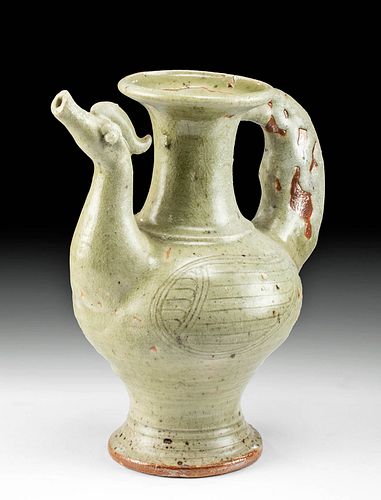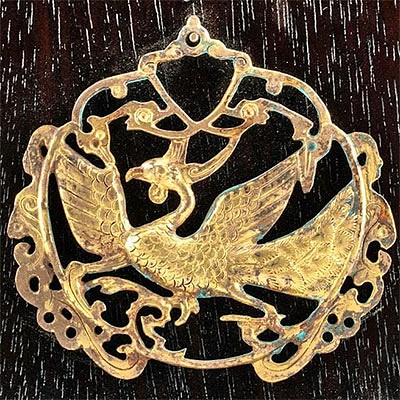Korean Koryo Celadon Pottery Phoenix Pitcher
Lot 115
About Seller
Artemis Fine Arts
686 S Taylor Ave, Ste 106
Louisville, CO 80027
United States
Selling antiquities, ancient and ethnographic art online since 1993, Artemis Gallery specializes in Classical Antiquities (Egyptian, Greek, Roman, Near Eastern), Asian, Pre-Columbian, African / Tribal / Oceanographic art. Our extensive inventory includes pottery, stone, metal, wood, glass and textil...Read more
Categories
Estimate:
$1,000 - $1,500
Absentee vs Live bid
Two ways to bid:
- Leave a max absentee bid and the platform will bid on your behalf up to your maximum bid during the live auction.
- Bid live during the auction and your bids will be submitted real-time to the auctioneer.
Bid Increments
| Price | Bid Increment |
|---|---|
| $0 | $25 |
| $300 | $50 |
| $1,000 | $100 |
| $2,000 | $250 |
| $5,000 | $500 |
| $10,000 | $1,000 |
| $20,000 | $2,500 |
| $50,000 | $5,000 |
| $100,000 | $10,000 |
| $200,000 | $20,000 |
About Auction
By Artemis Fine Arts
Jun 17, 2021
Set Reminder
2021-06-17 10:00:00
2021-06-17 10:00:00
America/New_York
Bidsquare
Bidsquare : Ancient & Ethnographic Art Through The Ages
https://www.bidsquare.com/auctions/artemis-gallery/ancient-ethnographic-art-through-the-ages-7094
Ancient art from Egypt, Greece, Italy and the Near East, as well as Asian, Fossils, Pre-Columbian, Native American, African / Tribal / Oceanic, Fine art, and much more! All categories, all price ranges... all legally acquired and guaranteed to be as described or your money back. Artemis Fine Arts info@artemisfinearts.com
Ancient art from Egypt, Greece, Italy and the Near East, as well as Asian, Fossils, Pre-Columbian, Native American, African / Tribal / Oceanic, Fine art, and much more! All categories, all price ranges... all legally acquired and guaranteed to be as described or your money back. Artemis Fine Arts info@artemisfinearts.com
- Lot Description
East Asia, Korea, Koryo Dynasty, ca. 10th to 13th century CE. A triumphant celadon glazed pottery pitcher depicting a phoenix with a cocked head and a spouted beak. This greenware porcelain bird has carefully incised wings on opposite ends, and appliqued facial features including circular eyes, a prominent brow line, and a flamboyantly raised hairstyle. A thick strap handle rises from the back of the bulbous body to the bottom of the vessel’s flared lip. The celadon glaze was allowed to flow freely over the handle, and the vessel was fired in such a way that the potter was able to create a multi-textural effect. Three linear incisions delineate the concaved base and gently flared foot. A beautiful piece to say the least! Size: 7.25" L x 6.5" W x 9.25" H (18.4 cm x 16.5 cm x 23.5 cm)
To create this ware, artisans apply a wash of slip (liquefied clay), which contains a high proportion of iron, to the body of the stoneware before glazing. The iron interacts with the glaze during the firing and colors it one of various shades of green. First made in China, celadon was exported to India, Persia, and Egypt in the Tang dynasty (618–907), to most of Asia in the Song (960–1279) and Ming (1368–1644) dynasties, and to Europe in the 14th century. The ware was popular because of its beauty; the Chinese also valued it because it resembled jade. Adding to its popularity was a widely believed superstition suggesting that a celadon dish would break or change color if poisoned food were put into it. The first step is bisque firing, which dries out and hardens unglazed vessels to make them stable and easier to handle. The second step involves firing glazed vessels in a low oxygen “reducing” atmosphere to produce the desired celadon color and glossy texture. Korean celadons of the Koryo period had a glaze that varied from bluish green to a putty color. Many of the forms were lobed, based on the melon or the gourd. Chinese potters, known for originating the practice, fired their celadons in brick kilns, but Korean artisans used traditional mud kilns that effectively blocked the flow of oxygen to produce a brilliant celadon tone. Korean potters adapted and refined celadon technology from China to create distinctively Korean ceramics revered by elites in Korea, China, Japan, and now the entire world alike.
Provenance: ex Ashland University Museum, Ashland, Ohio, USA
All items legal to buy/sell under U.S. Statute covering cultural patrimony Code 2600, CHAPTER 14, and are guaranteed to be as described or your money back.
A Certificate of Authenticity will accompany all winning bids.
We ship worldwide and handle all shipping in-house for your convenience.
#164852Hairline fissure along the inside of rim atop. Fissures also visible at top and bottom of handle. Minor chips to glaze scattered throughout. Softening to incised wings - commensurate with age. Otherwise in good condition and intact.Condition
- Shipping Info
-
All shipping is handled in-house for your convenience. Your invoice from Artemis Gallery will include shipping calculation instructions. If in doubt, please inquire BEFORE bidding for estimated shipping costs for individual items.
-
- Buyer's Premium



 EUR
EUR CAD
CAD AUD
AUD GBP
GBP MXN
MXN HKD
HKD CNY
CNY MYR
MYR SEK
SEK SGD
SGD CHF
CHF THB
THB













